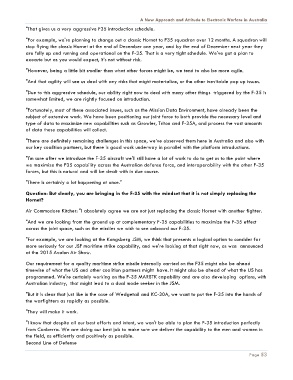Page 54 - Williams Foundation Future of Electronic Warfare Seminar
P. 54
A New Approach and Attitude to Electronic Warfare in Australia
"That gives us a very aggressive F35 introduction schedule.
"For example, we're planning to change out a classic Hornet to F35 squadron over 12 months. A squadron will
stop flying the classic Hornet at the end of December one year, and by the end of December next year they
are fully up and running and operational on the F-35. That is a very tight schedule. We've got a plan to
execute but as you would expect, it’s not without risk.
"However, being a little bit smaller than what other forces might be, we tend to also be more agile.
"And that agility will see us deal with any risks that might materialize, or the other inevitable pop up issues.
"Due to this aggressive schedule, our ability right now to deal with many other things triggered by the F-35 is
somewhat limited, we are rightly focused on introduction.
"Fortunately, most of these associated issues, such as the Mission Data Environment, have already been the
subject of extensive work. We have been positioning our joint force to both provide the necessary level and
type of data to maximize new capabilities such as Growler, Triton and F-35A, and process the vast amounts
of data these capabilities will collect.
"There are definitely remaining challenges in this space, we’ve observed them here in Australia and also with
our key coalition partners, but there is good work underway in parallel with the platform introductions.
"I'm sure after we introduce the F-35 aircraft we'll still have a lot of work to do to get us to the point where
we maximize the F35 capability across the Australian defense force, and interoperability with the other F-35
forces, but this is natural and will be dealt with in due course.
"There is certainly a lot happening at once."
Question: But clearly, you are bringing in the F-35 with the mindset that it is not simply replacing the
Hornet?
Air Commodore Kitcher: "I absolutely agree we are not just replacing the classic Hornet with another fighter.
"And we are looking from the ground up at complementary F-35 capabilities to maximize the F-35 effect
across the joint space, such as the missiles we wish to see onboard our F-35.
"For example, we are looking at the Kongsberg JSM, we think that presents a logical option to consider far
more seriously for our JSF maritime strike capability, and we're looking at that right now, as was announced
at the 2015 Avalon Air Show.
Our requirement for a quality maritime strike missile internally carried on the F35 might also be ahead
timewise of what the US and other coalition partners might have. It might also be ahead of what the US has
programmed. We're certainly working on the F-35 MARSTK capability and are also developing options, with
Australian Industry, that might lead to a dual mode seeker in the JSM.
"But it is clear that just like in the case of Wedgetail and KC-30A, we want to put the F-35 into the hands of
the warfighters as rapidly as possible.
"They will make it work.
"I know that despite all our best efforts and intent, we won't be able to plan the F-35 introduction perfectly
from Canberra. We are doing our best job to make sure we deliver the capability to the men and women in
the field, as efficiently and positively as possible.
Second Line of Defense
Page 53

